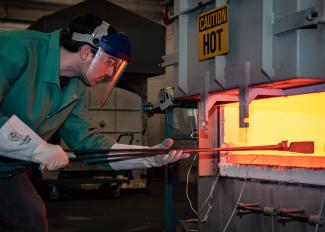For NETL researchers like Madison Wenzlick, the field of data analytics holds the key to unlocking the development of alloys needed to operate the next generation of U.S. power plants and keep Americans supplied with abundant, affordable electricity.
However, as Wenzlick and her colleagues explain in their recently published article, the availability of high-quality data to design advanced alloys, which are needed to manufacture stronger, heat-resistant power plant components, is limited.
“The relevant data for high-temperature alloy design are scattered. There is no central repository of alloy data that can be readily mined,” the researchers wrote in the article, “Data Assessment Method to Support the Development of Creep-Resistant Alloys,” which was published in the Integrating Materials and Manufacturing Innovation journal.
“Often the required information is offline and resides in laboratory notebooks or as unwritten expert knowledge,” the authors noted.
Addressing the data deficiency is an NETL priority.
Access to data and information from scientific literature, experiments and physics-based modeling and simulations provide the foundation for accelerated materials development. Once data are organized and curated, machine learning (ML) algorithms can be used to analyze the collected data, to find trends and connections in the data to support materials property prediction, and to increase the efficiency of materials design.
“With quality data, we can use ML to design resilient, low-cost alloys and predict with greater accuracy their durability in extreme environments,” said Wenzlick, the article’s lead author who is part of NETL’s data science team and is collaborating with NETL’s advanced alloy development team for this research.
Heat-resistant alloys are needed in the fossil energy (FE) sector to ensure reliable electricity for the nation. Through data analysis, computational models can be used to design alloys to perform at higher operating temperatures and stresses to achieve higher efficiencies in the next generation of coal-powered plants and during cycling (the process of turning off and on a plant in response to system load or demand).
Boilers and other components made from stronger alloys also will be better equipped to handle the stresses of frequent startups and shutdowns required to support widespread addition of renewable energy sources to the grid.
The research is part of the NETL-led, U.S. Department of Energy eXtremeMAT project, which brings together seven leading DOE National Laboratories to harness their unique capabilities for materials design, high-performance computing, manufacturing and characterization that exist across the DOE complex to accelerate the development of materials for service in extreme environments needed to improve the existing fleet and enable advanced fossil energy systems.
The work undertaken by Wenzlick and her co-workers is focused on developing methodologies and new tools to assess data quality needed to design superior alloys. To achieve that goal, the Energy Data eXchange™, NETL’s data hosting and collaboration platform, was deployed to provide a defined method to more effectively curate datasets and use the information in subsequent analyses.
Ratings are now assigned to data in four areas — completeness, accuracy, usability and standardization (a value in the level of confidence in the source of a dataset). These rating definitions provide a standard methodology to compare data across varying sources, determine gaps in information, reduce uncertainty to a significant extent and provide data to validate newly designed alloys for use in FE power generation against existing ones.
It will be a busy year for Wenzlick and her colleagues.
“We will continue to add information to the database and to expand the range of properties to address alloy fatigue in particular. Part of the activities are finding information and preparing it for inclusion in the database and part of it will involve NETL internal testing on experimental alloys and other heritage alloys for use in new power plants and those in the existing fleet,” said Jeff Hawk, another member of the Structural Materials Team and article co-author.




